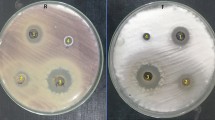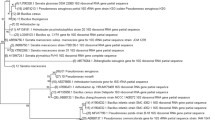Abstract
This study was conducted to investigate biocontrol potential of Paenibacillus ehimensis KWN38 against Fusarium oxysporum f.sp. lycopersici causing Fusarium wilt disease in tomato. Our result showed that P. ehimensis KWN38 produced extracellular organic compounds and crude enzyme to inhibit F. oxysporum f.sp. lycopersici conidial germination in in vitro assays. Tomato seedlings were treated with water (W), grass medium (G), G with P. ehimensis KWN38 inoculation (GP) and G along with synthetic fungicide (GSf). Disease symptoms were was first observed in G and W at 12 days after infection (DAI) while symptoms were noticeable in the GP and GSf treatments at 20 and 24 DAI, respectively. Tomato plants treated with P. ehimensis KWN38 or fungicide significantly reduced Fusarium wilt disease incidence and severity as compared to control tomato plants treated with water and grass medium. The similar results were also found in the root mortality of tomato plants. At 25 DAI, most plants in control treatments (W and G) wilted and the brown vascular systems of infected plants was clearly differentiable from normal green vascular system of healthy plants from GP and GSf. Plants in the GP showed higher fresh and dry weights of both root and shoots than those in W and G treatments. Leaf peroxidase and polyphenol oxidase activities of tomato plants in G and W were higher than those in GP and GSf. Root enzyme activities showed a similar pattern but the values were higher than leaf enzyme. The results clearly demonstrated that P. ehimensis KWN38 may be considered as biocontrol agent of Fusarium wilt disease in tomato.







Similar content being viewed by others
References
Abdel-Ghaffar AS (1989) Aspects of microbial activities and nitrogen fixation in Egyptian desert soils. Arid Soil Res Rehab 3:281–294
Ahemad M, Khan MS (2012) Alleviation of fungicide-induced phytotoxicity in greengram [Vigna radiata (L.) Wilczek] using fungicide-tolerant and plant growth promoting Pseudomonas strain. Saudi J Biol Sci 9:451–459
Anitha A, Rabeeth M (2009) Control of Fusarium wilt of tomato by bioformulation of Streptomyces griseus in green house condition. Afr J Bas Appl Sci 1:9–14
Anokhina TO, Volkova OV, Puntus IF, Filonov AE, Kochetkov VV, Boronin AM (2006) Plant growth-promoting Pseudomonas bearing catabolic plasmids: naphthalene degradation and effect on plants. Process Biochem 41:2417–2423
Bradford MM (1976) Rapid and sensitive method for the quantitation of microgram quantities of protein utilizing the principle of protein-dye binding. Anal Biochem 72:248–254
Budi SW, van Tuinen D, Arnould C, Dumas-Gaudot E, Gianinazzi-Pearson V, Gianinazzi S (2000) Hydrolytic enzyme activity of Paenibacillus sp. Strain B2 and effects of the antagonistic bacterium on cell integrity of two soil-borne pathogenic fungi. Appl Soil Ecol 15:191–199
Chance B, Maehly AC (1955) Assay of catalases and peroxidases. Method Enzymol 2:764–775
Chandel S, Allan EJ, Woodward S (2010) Biological control of Fusarium oxysporum f. sp. lycopersici on tomato by Brevibacillus brevis. J Phytopathol 158:470–478
Chaudhry V, Chauhan PS, Mishra A, Goel R, Asif HH, Mantri SS, Bag SK, Singh SK, Sawant SV, Nautiyal CS (2013) Insights from the draft genome of Paenibacillus lentimorbus NRRL B-30488, a promising plant growth promoting bacterium. J Biotechnol 168:737–738
Chittoor JM, Leach JE, White EF (1999) Induction of peroxidase during defence against pathogens. In: Datta SK, Muthukrishnan SK (eds) Pathogenesis-Related Proteins in Plants. CRC Press, New York, pp 171–193
Das S, Aggarwal R, Singh DV (2003) Differential induction of defense related enzymes involved in lignin biosynthesis in wheat in response to bloth infection. Indian Phytopathol 56:129–133
Dukare AS, Prasanna R, Dubey SC, Nain L, Chaudhary V, Singh R, Saxena AK (2011) Evaluating novel microbe amended composts as biocontrol agents in tomato. Crop Prot 30:436–442
Garg SK, Bhatnagar A, Kalla A, Narula N (2001) In vitro nitrogen fixation, phosphate solubilization, survival and nutrient release by Azotobacter strains in an aquatic system. Bioresour Technol 80:101–109
Gechev T, Willekens H, Montagu MV, Inzé D, Camp WV, Toneva V, Minkov I (2003) Different responses of tobacco antioxidant enzymes to light and chilling stress. J Plant Physiol 160:509–515
Ghosh PK, Saha P, Mayilraj S, Maiti TK (2013) Role of IAA metabolizing enzymes on production of IAA in root, nodule of Cajanus cajan and its PGP Rhizobium sp. Biocatal Agric Biotechnol 2:234–239
Ghyselinck J, Velivelli SL, Heylen K, O’Herlihy E, Franco J, Rojas M, Vos PD, Prestwich BD (2013) Bioprospecting in potato fields in the Central Andean Highlands: screening of rhizobacteria for plant growth-promoting properties. Syst Appl Microbiol 36:116–127
Gordon TR, Martyn RD (1997) The evolutionary biology of Fusarium oxysporum. Annu Rev Phytopathol 35:111–128
Hariprasad P, Divakara ST, Niranjana SR (2011) Isolation and characterization of chitinolytic rhizobacteria for the management of Fusarium wilt in tomato. Crop Prot 30:1606–1612
Hibar K, Daami-Remadi M, El Mahjoub M (2007) Induction of resistance in tomato plants against Fusarium oxysporum f. sp. radicis-lycopersici by Trichoderma spp. Tunis J Plant Prot 2:47–58
Hunt M, Ryals J (1996) Systemic acquired resistance signal transduction. Critl Rev Plant Sci 15:583–606
Jones JB, Jones JP, Stall RE, Zitter TA (1991) Compendium of tomato diseases. APS Press, St. Paul
Kamilova F, Validov S, Azarova T, Mulders I, Lugtenberg B (2005) Enrichment for enhanced competitive plant root tip colonizers selects for a new class of biocontrol bacteria. Env Microbiol 7:1809–1817
Karpinski S, Escobar C, Karpinska B, Creissen G, Mullineaux PM (1997) Photosynthetic electron transport regulates the expression of cytosolic ascorbate peroxidase genes in Arabidopsis during excess light stress. Plant Cell 9:627–640
Kloepper JW, Ryu CM, Zhang S (2004) Induced systemic resistance and promotion of plant growth by Bacillus spp. Phytopathology 94:1259–1266
Knievel DP (1973) Procedures for estimating ratio of live or dead root dry matter in root core samples. Crop Sci 13:124–126
Kumar S, Jaggi M, Sinha AK (2012) Ectopic overexpression of vacuolar and apoplastic Catharanthus roseus peroxidases confers differential tolerance to salt and dehydration stress in transgenic tobacco. Protoplasma 249:423–432
Li L, Steffens JC (2002) Overexpression of polyphenol oxidase in transgenic tomato plants results in enhanced bacterial disease resistance. Planta 215:239–247
Li SM, Hua GG, Liu HX, Guo JH (2008) Analysis of defence enzymes induced by antagonistic bacterium Bacillus subtilis strain AR12 towards Ralstonia solanacearum in tomato. Annu Rev Phytopathol 58:573–578
Markunas I, Gmerek S (2007) The possible involvement of perioxidase in defense of yellow lupin embryo axes against Fusarium oxysporum. J Plant Physiol 164:497–506
Marzano M, Gallo A, Altomare C (2013) Improvement of biocontrol efficacy of Trichoderma harzianum vs. Fusarium oxysporum f. sp. lycopersici through UV-induced tolerance to fusaric acid. Biol Control 67:397–408
Mayer AM (1987) Polyphenol oxidase in plants-recent progress. Phytochemistry 26:11–20
Mayer AM, Harel E (1979) Polyphenol oxidases in plants. Phytochemistry 18:193–215
Myresiotis CK, Vryzas Z, Papadopoulou-Mourkidou E (2014) Enhanced root uptake of acibenzolar-S-methyl (ASM) by tomato plants inoculated with selected Bacillus plant growth-promoting rhizobacteria (PGPR). Appl Soil Ecol 77:26–33
Naing KW, Anees M, Kim SJ, Nam Y, Kim YC, Kim KY (2014a) Characterization of antifungal activity of Paenibacillus ehimensis KWN38 against soilborne phytopathgenic fungi belonging to various taxonomic groups. Ann Microbiol 64:55–63
Naing KW, Anees M, Nguyen XH, Lee YS, Jeon SW, Kim SJ, Kim MH, Kim KY (2014b) Biocontrol of late blight disease (Phytophthora capsici) of pepper and the plant growth promotion by Paenibacillus ehimensis KWN38. J Phytopathol 162:367–376
Oliveira MF, da Silva MG, van der Sand ST (2010) Anti-phytopathogen potential of endophytic actinobacteria isolated from tomato plants (Lycopersicon esculentum) in southern Brazil, and characterization of Streptomyces sp. R18 (6), a potential biocontrol agent. Res Microbiol 161:565–572
Pichard B, Larue JP, Thouvenot D (1995) Gavaserin and saltavalin, new peptide antibiotics produced by Bacillus polymyxa. FEMS Microbiol Lett 133:215–218
Pieterse CMJ, Van Wees SCM, Hoffland E, Van Pelt JA, Van Loon LC (1996) Systemic resistance in Arabidopsis induced by biocontrol bacteria is independent of salicylic acid accumulation and pathogenesis-related gene expression. Plant Cell 8:1225–1237
Pieterse CMJ, Van Pelt JA, Van Wees SCM, Ton J, Léon-Kloosterziel KM, Keurentjes JJB, Verhagen BWM, Knoester M, Van der Sluis I, Bakker PAHM, Van Loon LC (2001) Rhizobacteria mediated induced systemic resistance: triggering, signaling and expression. Eur J Plant Pathol 107:51–61
Pimentel D, Levitan L (1986) Pesticides: amounts applied and amounts reaching pests. Bioscience 36:86–91
Rajendran G, Sing F, Desai AJ, Archana G (2008) Enhanced growth and nodulation of pigeon pea by co-inoculation of Bacillus strains with Rhizobium spp. Bioresour Technol 99:4544–4550
Ramamoorthy V, Raguchander T, Samiyappan R (2002) Induction of defense-related proteins in tomato roots treated with Pseudomonas fluorescens Pf1 and Fusarium oxysporum f. sp. lycopersici. Plant Soil 239:55–68
Rodelas B, GonzaÂlez-LoÂpez J, Pozo C, SalmeroÂn V, MartõÂnez-Toledo MV (1999) Response of Faba bean (Vicia faba L.) to combined inoculation with Azotobacter and Rhizobium leguminosarum bv. Viceae. Appl Soil Ecol 12:51–59
Saidi N, Kouki S, M’Hiri F, Hajlaoui MR, Mahrouk M, Ouzari H, Jedidi N, Hassen A (2009) Characterization and selection of Bacillus sp. strains, effective biocontrol agents against Fusarium oxysporum f. sp. radicis-lycopersici, the causal agent of Fusarium crown and root rot in tomato. Ann Microbiol 59:191–198
SAS Institute Inc (2008) SAS/STAT ® 9.2 User’s Guide. Cary, NC
Shaner G, Finney RE (1977) The effect of nitrogen fertilization on the expression of slow-mildewing resistance in Knox wheat. Phytopathology 67:1051–1056
Shanmugam V, Kanoujia N (2011) Biological management of vascular wilt of tomato caused by Fusarium oxysporum f.sp. lycopersici by plant growth-promoting mixture. Biocontrol 57:85–93
Shivakumar PD, Geetha HM, Shetty HS (2003) Peroxidase activity and isozyme analysis of pearl millet seedlings and their implications in downy mildew disease resistance. Plant Sci 164:85–93
Shoebitz M, Ribaudo CM, Pardo MA, Cantore ML, Ciampi L, Cura´ JA (2009) Plant growth promoting properties of a strain of Enterobacter ludwigii isolated from Lolium perenne rhizosphere. Soil Biol Biochem 41:1768–1774
Srivastava R, Khalid A, Singh US, Sharma AK (2010) Evaluation of arbuscular mycorrhizal fungus, fluorescent Pseudomonas and Terichoderma harzianum formulation against Fusarium oxysporum f.sp. lycopersici for the management of tomato wilt. Biol Control 53:24–31
Vieira FA, Carvalhoa AO, Vito´ria AP, Retamal CA, Gomes VM (2010) Differential expression of defence-related proteins in Vigna unguiculata (L. Walp.) seedlings after infection with Fusarium oxysporum. Crop Prot 29:440–447
Wong TC, Luh BS, Whitaker JR (1971) Isolation and characterization of polyphenol oxidase isozymes of Clingstone peach. Plant Physiol 48:19–23
Yedidia I, Benhamou N, Kapulnink Y, Chet I (2000) Induction and accumulation of PR proteins activity during early stages of root colonization by the mycoparasite Trichoderma harzianum strain T-203. Plant Physiol Biochem 38:863–873
Acknowledgments
This research was supported by iPET (Korea Institute of Planning and Evaluation for Technology in Food, Agriculture, Forestry and Fisheries, under the Grant (No. 311017-3), Ministry for Food, Agriculture, Forestry and Fisheries, Republic of Korea.
Conflict of interest
Authors declare that there is no financial/commercial conflict of interest about this research.
Author information
Authors and Affiliations
Corresponding author
Electronic supplementary material
Below is the link to the electronic supplementary material.
Rights and permissions
About this article
Cite this article
Naing, K.W., Nguyen, X.H., Anees, M. et al. Biocontrol of Fusarium wilt disease in tomato by Paenibacillus ehimensis KWN38. World J Microbiol Biotechnol 31, 165–174 (2015). https://doi.org/10.1007/s11274-014-1771-4
Received:
Accepted:
Published:
Issue Date:
DOI: https://doi.org/10.1007/s11274-014-1771-4




